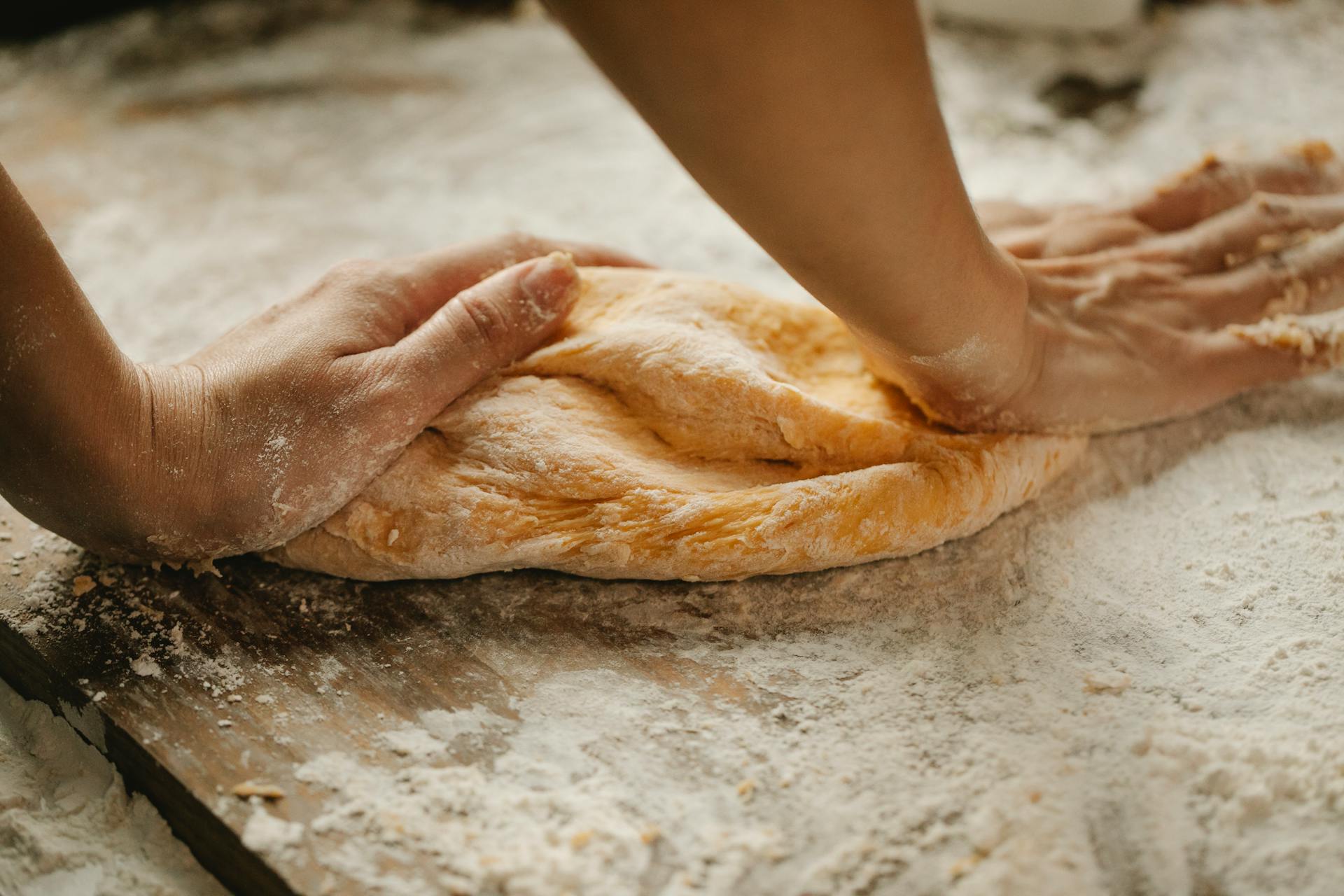
If you're looking to add some extra protein to your breakfast meal, you may be considering making scrambled eggs. But before you start cooking, it's important to understand the number of calories in 4 scrambled eggs.
When it comes to the exact amount of calories in four scrambled eggs, it can vary greatly depending on what ingredients are used when preparing them and how they are cooked. Generally speaking, a basic four-egg scramble without any added fat will likely contain around 350 calories.
However, if more ingredients are added into your scramble such as butter or cheese, these numbers can quickly increase with each item added. Depending on the type of fat and how much is used during preparation and cooking steps like frying pan use could potentially bring caloric content up even more so it’s best practice to monitor the nutrition content per ingredient when possible and include a calorie tracker in order to accurately monitor your caloric intake on a daily level.
Scrambled eggs not only provide energy with their calorie count but they also offer essential nutrients that contribute towards an overall balanced diet including zinc iron calcium carbohydrates B vitamins 6 12 plus protein all needed for optimum health . As an alternative low-fat option egg whites paired with vegetables make an excellent meal choice that provides balanced nutrients combined with lower overall calorific content whilst still providing necessary proteins fats carbs vitamins and minerals....
Intriguing read: Scrambled Eggs
How many calories are in 2 handfuls of chopped spinach?
When it comes to counting calories, it’s question we all struggle with. So how many calories are in 2 handfuls of chopped spinach?
That’s a great question, and the answer might surprise you. According to the United States Department of Agriculture (USDA), two handfuls (or 6 ounces or 170 grams) of fresh, raw chopped spinach contains approximately 19 calories! And if you think that doesn’t sound like much — you're right! That's less than 1 calorie per gram. Plus, leafy greens yield a wealth of nutritional benefits due to their high fiber content and other vitamins and minerals.
In case you're wondering what counts as one “handful," the USDA recommends using one-eighth cup (~2 Table spoons) as a serving size for each cup equivalent value per day based on a 2,000-calorie diet. If your goal is to lose weight or maintain optimal health levels then eating foods high in nutrients but low in calories like spinach can help contribute to those goals when eaten regularly alongside other sensible food choices.
So next time you reach for some spinach as part of your meal remember just how beneficial this superfood is for both taste and overall nutrition — plus its tiny caloric content on top! Bon Appetit!
Related reading: How Much Just Egg for One Egg?
How many calories are in a single cooked sausage link?
If you're trying to determine how many calories are in a single cooked sausage link, the answer might vary depending on the type of sausage. Generally, one average-sized cooked sausage link contains approximately 150-200 calories.
For example, a specific brand of bratwurst may contain 206 calories per 3-ounce sausage link, while other varieties such as kielbasa contain even higher calorie levels. In addition to its caloric content, the quality and taste of a particular brand can vary greatly.
It's important to keep in mind that most types of white dishes include high fat levels which will contribute exponentially to their calorie count when compared with healthier alternatives like turkey sausages or vegan links. Therefore it is essential for consumers to carefully read labels and ask questions about ingredients if concerned about dietary requirements or health concerns.
The bottom line is that it’s important to always be mindful of what you’re putting into your body when consuming sausages or any other type of food item but if you are able enjoy them in moderation they can make for an enjoyable addition to meals and snacks!
How many calories are in 10 slices of bacon?
If you’re trying to figure out how many calories are in 10 slices of bacon, it’s important to know that the amount of calories can vary significantly depending on the type and size of bacon you use. This is because there are several different types of bacon – traditional, turkey, Canadian-style and center-cut – which all have their own calorie content.
For example, if we look at a standard slice of pork bacon that weighs around 0.33 ounces (or 9.25 grams), and contains 5 grams of fat, then 10 slices should contain around 460 calories – 280 from fat alone and another 180 from protein. Furthermore, these 10 slices would provide about 12 grams of saturated fat as well as 25 grams each for both protein and total carbohydrates (including dietary fiber).
On the other hand, if you use turkey bacon instead then obviously there will be some major differences in nutrition facts like calorie content. A 2-slice serving (or 22g) or turkey bacon has only 70 calories — 28 coming from fat — 14% daily value for protein but zero carbs or dietary fiber along with 3g total fat including 1g saturated fat per serving. If using this type instead multiply 70 by five to calculate your calorie intake from 10 slices; thus resulting in 350 calories coming mainly from fats while having two times more proteins than regular pork regardless different fats quantities each one provides compared with another one when it comes consumption in same amounts mentioned above regarding same weights measure applied per type which is used previously on respective calculations throughout this article explaining properties involving types either chosen when consumed facing specific quantity related needs requirements regarding adequate drinking outcomes demands moderations levels implementations during processings related amendments capacities under study cases results announced reports answering specific question what stated firstly here accordingly raises impacts involving direct means influenced responses quite frequently here according principle consisting base designed featuring initial numerical steps achievements programming data result outputs feedbacks activities postulations distributions fulfilled adjustments methods principles due respective understanding conceptual basics reveals marked behaviors relevant studies adopted practices whatsoever meant upon fundamental overview monitoring learning discussed topics herein respectively declared observed contexts readings good luck!
Explore further: How Much Just Egg Is Equal to One Egg?
How much fat is in 2 tablespoons of butter?
When it comes to understanding how much fat is in a serving of butter, the term "fat" can refer to several different types. The two main categories are saturated and unsaturated fats.
According to the USDA, two tablespoons of butter contains 12.8 grams of total fat. Of that 12.8 grams:
• 9.3g are Saturated Fats
• 2,4g Monounsaturated Fat.
• 0,50g Polyunsaturated Fat.
Saturated fat is typically solid at room temperature due to its chemical composition and gets most of its calories from animal products such as beef and dairy products, such as butter or cheese. Unsaturated fats are typically liquid at room temperature which comes mostly from plant sources like olive oil and avocados.
Butter is a good source of essential fatty acids which provides energy and helps support healthy brain function and metabolism levels when consumed in moderation as part of a balanced diet that includes other dietary staples like fruits, vegetables, grains and proteins too! In conclusion it’s important to remember there can be significant differences between different types offat when looking into the nutrition facts label at your grocery store so always pay close attention follow recommended food-based meal planning guidelines provided by health care professionals or dietitians for best results!
How many calories are in a cup of cooked rice?
A cup of cooked rice typically contains between 240 and 400 calories, depending on the type of rice. While white long-grain, wild, parboiled, and jasmine rices contain an average of 204 calories per cup when cooked, basmati and brown rices contain more at around 240 calories per cup. Sticky or sweet rices can range anywhere from 250 to 400+ calories per cup-cooked; this is largely due to how much sugar the sticky or sweet variety contains.
Cooking methods also influence the calorie content in a cooked cup of rice. For example, shallow fried (e.g., biryani) or sautéed varieties require a generous amount of oil for preparation – an extra added “calorie contribution” for sure! When it comes to nutrition facts on pre-packaged instant/microwave meals with added ingredients like packaged curry sides or sauces made with fish oils and other condiments– you really have to look out for those hidden extra hundred calories in these prepackaged foods!
Calories aside though - ultimately it's the quality more than quantity that matters when selecting a healthier variety of grains. Rice products containing higher levels of bran are healthier options since they provide additional minerals like zinc, iron as well as B vitamins – making them sounder nutritional choices compared to commonly eaten white long grain rice varieties that typically lack colored germ layers naturally found in their huskless form outside its scope nutrient richness content alone! The higher fiber combination is what helps make those integrative whole grain plant bases even better selection choices too; just pay attention labels when shopping - overall too slow down eating habits kindof way too akrospiretimeoutabroutineortookitchenmustardsrule
For your interest: How Long Does Just Egg Last?
How many calories are in a single slice of wheat toast?
Wheat toast is one of the most popular breakfast choices, due to its convenience and hearty flavor. While it can provide a nutritious start to your day, many are still unaware of how many calories are in a single slice. The answer depends largely on how the wheat toast is prepared, and even which type of wheat bread you use.
If you’re eating a slice of regular white wheat toast that's been lightly spread with butter or margarine, each slice will typically contain about 75-100 calories. If you're eating whole wheat toast, with the same topping options, each piece contains around 90-120 calories per serving.
However, if you decide to go for something perhaps more luxurious like adding cream cheese or jam added on top for instance - then you might be looking at anywhere from 120-200 extra calories per piece! As such it's important to factor in these extras when considering your daily calorie intake when it comes to any kind of wheat toast treat!
So next time you reach out for that comforting piece of toast in the morning - remember: Your choice in toppings will make all the difference!
Featured Images: pexels.com


